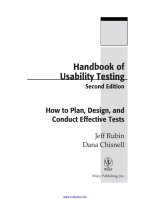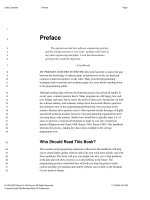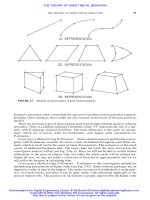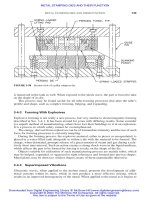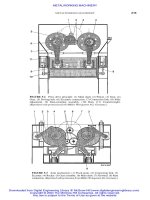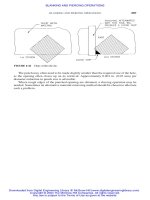Microsoft press code complete a practical handbook of software construction 2nd edition jul 2004 ISBN 0735619670
Bạn đang xem bản rút gọn của tài liệu. Xem và tải ngay bản đầy đủ của tài liệu tại đây (9.64 MB, 1,806 trang )
CodeComplete,SecondEdition
BySteveMcConnell
...............................................
Publisher:MicrosoftPress
PubDate:June09,2004
PrintISBN:0-7356-1967-0
Pages:960
TableofContents|Index
Takeastrategicapproachtosoftwareconstructionandproducesuperiorproductswiththisfully
updatededitionofSteveMcConnell'scriticallypraisedandaward-winningguidetosoftware
developmentbestpractices.
CodeComplete,SecondEdition
BySteveMcConnell
...............................................
Publisher:MicrosoftPress
PubDate:June09,2004
PrintISBN:0-7356-1967-0
Pages:960
TableofContents|Index
Copyright
Preface
WhoShouldReadThisBook?
WhereElseCanYouFindThisInformation?
KeyBenefitsofThisHandbook
WhyThisHandbookWasWritten
AuthorNote
Acknowledgments
AbouttheAuthor
SteveMcConnell
PartI:LayingtheFoundation
Inthispart:
Chapter1.WelcometoSoftwareConstruction
Section1.1.WhatIsSoftwareConstruction?
Section1.2.WhyIsSoftwareConstructionImportant?
Section1.3.HowtoReadThisBook
KeyPoints
Chapter2.MetaphorsforaRicherUnderstandingofSoftwareDevelopment
Section2.1.TheImportanceofMetaphors
Section2.2.HowtoUseSoftwareMetaphors
Section2.3.CommonSoftwareMetaphors
KeyPoints
Chapter3.MeasureTwice,CutOnce:UpstreamPrerequisites
Section3.1.ImportanceofPrerequisites
Section3.2.DeterminetheKindofSoftwareYou'reWorkingOn
Section3.3.Problem-DefinitionPrerequisite
Section3.4.RequirementsPrerequisite
Section3.5.ArchitecturePrerequisite
Section3.6.AmountofTimetoSpendonUpstreamPrerequisites
AdditionalResources
KeyPoints
Chapter4.KeyConstructionDecisions
Section4.1.ChoiceofProgrammingLanguage
Section4.2.ProgrammingConventions
Section4.3.YourLocationontheTechnologyWave
Section4.4.SelectionofMajorConstructionPractices
KeyPoints
PartII:CreatingHigh-QualityCode
Inthispart:
Chapter5.DesigninConstruction
Section5.1.DesignChallenges
Section5.2.KeyDesignConcepts
Section5.3.DesignBuildingBlocks:Heuristics
Section5.4.DesignPractices
Section5.5.CommentsonPopularMethodologies
AdditionalResources
KeyPoints
Chapter6.WorkingClasses
Section6.1.ClassFoundations:AbstractDataTypes(ADTs)
Section6.2.GoodClassInterfaces
Section6.3.DesignandImplementationIssues
Section6.4.ReasonstoCreateaClass
Section6.5.Language-SpecificIssues
Section6.6.BeyondClasses:Packages
AdditionalResources
KeyPoints
Chapter7.High-QualityRoutines
Section7.1.ValidReasonstoCreateaRoutine
Section7.2.DesignattheRoutineLevel
Section7.3.GoodRoutineNames
Section7.4.HowLongCanaRoutineBe?
Section7.5.HowtoUseRoutineParameters
Section7.6.SpecialConsiderationsintheUseofFunctions
Section7.7.MacroRoutinesandInlineRoutines
KeyPoints
Chapter8.DefensiveProgramming
Section8.1.ProtectingYourProgramfromInvalidInputs
Section8.2.Assertions
Section8.3.Error-HandlingTechniques
Section8.4.Exceptions
Section8.5.BarricadeYourProgramtoContaintheDamageCausedbyErrors
Section8.6.DebuggingAids
Section8.7.DeterminingHowMuchDefensiveProgrammingtoLeaveinProduction
Code
Section8.8.BeingDefensiveAboutDefensiveProgramming
AdditionalResources
KeyPoints
Chapter9.ThePseudocodeProgrammingProcess
Section9.1.SummaryofStepsinBuildingClassesandRoutines
Section9.2.PseudocodeforPros
Section9.3.ConstructingRoutinesbyUsingthePPP
Section9.4.AlternativestothePPP
KeyPoints
PartIII:Variables
Inthispart:
Chapter10.GeneralIssuesinUsingVariables
Section10.1.DataLiteracy
Section10.2.MakingVariableDeclarationsEasy
Section10.3.GuidelinesforInitializingVariables
Section10.4.Scope
Section10.5.Persistence
Section10.6.BindingTime
Section10.7.RelationshipBetweenDataTypesandControlStructures
Section10.8.UsingEachVariableforExactlyOnePurpose
KeyPoints
Chapter11.ThePowerofVariableNames
Section11.1.ConsiderationsinChoosingGoodNames
Section11.2.NamingSpecificTypesofData
Section11.3.ThePowerofNamingConventions
Section11.4.InformalNamingConventions
Section11.5.StandardizedPrefixes
Section11.6.CreatingShortNamesThatAreReadable
Section11.7.KindsofNamestoAvoid
KeyPoints
Chapter12.FundamentalDataTypes
Section12.1.NumbersinGeneral
Section12.2.Integers
Section12.3.Floating-PointNumbers
Section12.4.CharactersandStrings
Section12.5.BooleanVariables
Section12.6.EnumeratedTypes
Section12.7.NamedConstants
Section12.8.Arrays
Section12.9.CreatingYourOwnTypes(TypeAliasing)
KeyPoints
Chapter13.UnusualDataTypes
Section13.1.Structures
Section13.2.Pointers
Section13.3.GlobalData
AdditionalResources
KeyPoints
PartIV:Statements
Inthispart:
Chapter14.OrganizingStraight-LineCode
Section14.1.StatementsThatMustBeinaSpecificOrder
Section14.2.StatementsWhoseOrderDoesn'tMatter
KeyPoints
Chapter15.UsingConditionals
Section15.1.ifStatements
Section15.2.caseStatements
KeyPoints
Chapter16.ControllingLoops
Section16.1.SelectingtheKindofLoop
Section16.2.ControllingtheLoop
Section16.3.CreatingLoopsEasilyFromtheInsideOut
Section16.4.CorrespondenceBetweenLoopsandArrays
KeyPoints
Chapter17.UnusualControlStructures
Section17.1.MultipleReturnsfromaRoutine
Section17.2.Recursion
Section17.3.goto
Section17.4.PerspectiveonUnusualControlStructures
AdditionalResources
KeyPoints
Chapter18.Table-DrivenMethods
Section18.1.GeneralConsiderationsinUsingTable-DrivenMethods
Section18.2.DirectAccessTables
Section18.3.IndexedAccessTables
Section18.4.Stair-StepAccessTables
Section18.5.OtherExamplesofTableLookups
KeyPoints
Chapter19.GeneralControlIssues
Section19.1.BooleanExpressions
Section19.2.CompoundStatements(Blocks)
Section19.3.NullStatements
Section19.4.TamingDangerouslyDeepNesting
Section19.5.AProgrammingFoundation:StructuredProgramming
Section19.6.ControlStructuresandComplexity
KeyPoints
PartV:CodeImprovements
Inthispart:
Chapter20.TheSoftware-QualityLandscape
Section20.1.CharacteristicsofSoftwareQuality
Section20.2.TechniquesforImprovingSoftwareQuality
Section20.3.RelativeEffectivenessofQualityTechniques
Section20.4.WhentoDoQualityAssurance
Section20.5.TheGeneralPrincipleofSoftwareQuality
AdditionalResources
KeyPoints
Chapter21.CollaborativeConstruction
Section21.1.OverviewofCollaborativeDevelopmentPractices
Section21.2.PairProgramming
Section21.3.FormalInspections
Section21.4.OtherKindsofCollaborativeDevelopmentPractices
ComparisonofCollaborativeConstructionTechniques
AdditionalResources
KeyPoints
Chapter22.DeveloperTesting
Section22.1.RoleofDeveloperTestinginSoftwareQuality
Section22.2.RecommendedApproachtoDeveloperTesting
Section22.3.BagofTestingTricks
Section22.4.TypicalErrors
Section22.5.Test-SupportTools
Section22.6.ImprovingYourTesting
Section22.7.KeepingTestRecords
AdditionalResources
KeyPoints
Chapter23.Debugging
Section23.1.OverviewofDebuggingIssues
Section23.2.FindingaDefect
Section23.3.FixingaDefect
Section23.4.PsychologicalConsiderationsinDebugging
Section23.5.DebuggingToolsObviousandNot-So-Obvious
AdditionalResources
KeyPoints
Chapter24.Refactoring
Section24.1.KindsofSoftwareEvolution
Section24.2.IntroductiontoRefactoring
Section24.3.SpecificRefactorings
Section24.4.RefactoringSafely
Section24.5.RefactoringStrategies
AdditionalResources
KeyPoints
Chapter25.Code-TuningStrategies
Section25.1.PerformanceOverview
Section25.2.IntroductiontoCodeTuning
Section25.3.KindsofFatandMolasses
Section25.4.Measurement
Section25.5.Iteration
Section25.6.SummaryoftheApproachtoCodeTuning
AdditionalResources
KeyPoints
Chapter26.Code-TuningTechniques
Section26.1.Logic
Section26.2.Loops
Section26.3.DataTransformations
Section26.4.Expressions
Section26.5.Routines
Section26.6.RecodinginaLow-LevelLanguage
Section26.7.TheMoreThingsChange,theMoreTheyStaytheSame
AdditionalResources
KeyPoints
PartVI:SystemConsiderations
Inthispart:
Chapter27.HowProgramSizeAffectsConstruction
Section27.1.CommunicationandSize
Section27.2.RangeofProjectSizes
Section27.3.EffectofProjectSizeonErrors
Section27.4.EffectofProjectSizeonProductivity
Section27.5.EffectofProjectSizeonDevelopmentActivities
AdditionalResources
KeyPoints
Chapter28.ManagingConstruction
Section28.1.EncouragingGoodCoding
Section28.2.ConfigurationManagement
Section28.3.EstimatingaConstructionSchedule
Section28.5.TreatingProgrammersasPeople
Section28.6.ManagingYourManager
KeyPoints
Chapter29.Integration
Section29.1.ImportanceoftheIntegrationApproach
Section29.2.IntegrationFrequencyPhasedorIncremental?
Section29.3.IncrementalIntegrationStrategies
Section29.4.DailyBuildandSmokeTest
AdditionalResources
KeyPoints
Chapter30.ProgrammingTools
Section30.1.DesignTools
Section30.2.Source-CodeTools
Section30.3.Executable-CodeTools
Section30.4.Tool-OrientedEnvironments
Section30.5.BuildingYourOwnProgrammingTools
Section30.6.ToolFantasyland
AdditionalResources
KeyPoints
PartVII:SoftwareCraftsmanship
Inthispart:
Chapter31.LayoutandStyle
Section31.1.LayoutFundamentals
Section31.2.LayoutTechniques
Section31.3.LayoutStyles
Section31.4.LayingOutControlStructures
Section31.5.LayingOutIndividualStatements
Section31.6.LayingOutComments
Section31.7.LayingOutRoutines
Section31.8.LayingOutClasses
AdditionalResources
KeyPoints
Chapter32.Self-DocumentingCode
Section32.1.ExternalDocumentation
Section32.2.ProgrammingStyleasDocumentation
Section32.3.ToCommentorNottoComment
Section32.4.KeystoEffectiveComments
Section32.5.CommentingTechniques
Section32.6.IEEEStandards
AdditionalResources
KeyPoints
Chapter33.PersonalCharacter
Section33.1.Isn'tPersonalCharacterOfftheTopic?
Section33.2.IntelligenceandHumility
Section33.3.Curiosity
Section33.4.IntellectualHonesty
Section33.5.CommunicationandCooperation
Section33.6.CreativityandDiscipline
Section33.7.Laziness
Section33.8.CharacteristicsThatDon'tMatterAsMuchAsYouMightThink
Section33.9.Habits
AdditionalResources
KeyPoints
Chapter34.ThemesinSoftwareCraftsmanship
Section34.1.ConquerComplexity
Section34.2.PickYourProcess
Section34.3.WriteProgramsforPeopleFirst,ComputersSecond
Section34.4.ProgramintoYourLanguage,NotinIt
Section34.5.FocusYourAttentionwiththeHelpofConventions
Section34.6.PrograminTermsoftheProblemDomain
Section34.7.WatchforFallingRocks
Section34.8.Iterate,Repeatedly,AgainandAgain
Section34.9.ThouShaltRendSoftwareandReligionAsunder
KeyPoints
Chapter35.WheretoFindMoreInformation
Section35.1.InformationAboutSoftwareConstruction
Section35.2.TopicsBeyondConstruction
Section35.3.Periodicals
Section35.4.ASoftwareDeveloper'sReadingPlan
Section35.5.JoiningaProfessionalOrganization
Bibliography
Index
Copyright
PUBLISHEDBY
MicrosoftPress
ADivisionofMicrosoftCorporation
OneMicrosoftWay
Redmond,Washington98052-6399
Copyright©2004byStevenC.McConnell
Allrightsreserved.Nopartofthecontentsofthisbookmaybereproducedor
transmittedinanyformorbyanymeanswithoutthewrittenpermissionofthe
publisher.
LibraryofCongressCataloging-in-PublicationDataMcConnell,Steve
CodeComplete/SteveMcConnell.2nded.
p.cm.
Includesindex.
1.ComputerSoftwareDevelopmentHandbooks,manuals,etc.I.Title.
QA76.76.D47M392004
005.1dc222004049981
123456789QWT876543
DistributedinCanadabyH.B.FennandCompanyLtd.ACIPcataloguerecord
forthisbookisavailablefromtheBritishLibrary.
MicrosoftPressbooksareavailablethroughbooksellersanddistributors
worldwide.Forfurtherinformationaboutinternationaleditions,contactyour
localMicrosoftCorporationofficeorcontactMicrosoftPressInternational
directlyatfax(425)936-7329.VisitourWebsiteat
Sendcommentsto
Microsoft,MicrosoftPress,PowerPoint,VisualBasic,Windows,andWindows
NTareeitherregisteredtrademarksortrademarksofMicrosoftCorporationin
theUnitedStatesand/orothercountries.Otherproductandcompanynames
mentionedhereinmaybethetrademarksoftheirrespectiveowners.
Theexamplecompanies,organizations,products,domainnames,e-mail
addresses,logos,people,places,andeventsdepictedhereinarefictitious.No
associationwithanyrealcompany,organization,product,domainname,e-mail
address,logo,person,place,oreventisintendedorshouldbeinferred.
Thisbookexpressestheauthor'sviewsandopinions.Theinformationcontained
inthisbookisprovidedwithoutanyexpress,statutory,orimpliedwarranties.
Neithertheauthors,MicrosoftCorporation,noritsresellers,ordistributorswill
beheldliableforanydamagescausedorallegedtobecausedeitherdirectlyor
indirectlybythisbook.
AcquisitionsEditors:LindaEngelmanandRobinVanSteenburgh
ProjectEditor:DevonMusgrave
Indexer:BillMyers
PrincipalDesktopPublisher:CarlDiltz
BodyPartNo.X10-53130
Dedication
Tomywife,Ashlie,whodoesn'thavemuchtodowithcomputerprogramming
butwhohaseverythingtodowithenrichingtherestofmylifeinmoreways
thanIcouldpossiblydescribe
Preface
Thegapbetweenthebestsoftwareengineeringpracticeandtheaverage
practiceisverywideperhapswiderthaninanyotherengineering
discipline.Atoolthatdisseminatesgoodpracticewouldbeimportant.
FredBrooks
Myprimaryconcerninwritingthisbookhasbeentonarrowthegapbetweenthe
knowledgeofindustrygurusandprofessorsontheonehandandcommon
commercialpracticeontheother.Manypowerfulprogrammingtechniqueshide
injournalsandacademicpapersforyearsbeforetricklingdowntothe
programmingpublic.
Althoughleading-edgesoftware-developmentpracticehasadvancedrapidlyin
recentyears,commonpracticehasn't.Manyprogramsarestillbuggy,late,and
overbudget,andmanyfailtosatisfytheneedsoftheirusers.Researchersinboth
thesoftwareindustryandacademicsettingshavediscoveredeffectivepractices
thateliminatemostoftheprogrammingproblemsthathavebeenprevalentsince
the1970s.Becausethesepracticesaren'toftenreportedoutsidethepagesof
highlyspecializedtechnicaljournals,however,mostprogrammingorganizations
aren'tyetusingthemtoday.Studieshavefoundthatittypicallytakes5to15
yearsormoreforaresearchdevelopmenttomakeitswayintocommercial
practice(RaghavanandChand1989,Rogers1995,Parnas1999).Thishandbook
shortcutstheprocess,makingkeydiscoveriesavailabletotheaverage
programmernow.
WhoShouldReadThisBook?
Theresearchandprogrammingexperiencecollectedinthishandbookwillhelp
youtocreatehigher-qualitysoftwareandtodoyourworkmorequicklyandwith
fewerproblems.Thisbookwillgiveyouinsightintowhyyou'vehadproblems
inthepastandwillshowyouhowtoavoidproblemsinthefuture.The
programmingpracticesdescribedherewillhelpyoukeepbigprojectsunder
controlandhelpyoumaintainandmodifysoftwaresuccessfullyasthedemands
ofyourprojectschange.
ExperiencedProgrammers
Thishandbookservesexperiencedprogrammerswhowantacomprehensive,
easy-to-useguidetosoftwaredevelopment.Becausethisbookfocuseson
construction,themostfamiliarpartofthesoftwarelifecycle,itmakespowerful
softwaredevelopmenttechniquesunderstandabletoself-taughtprogrammersas
wellastoprogrammerswithformaltraining.
TechnicalLeads
ManytechnicalleadshaveusedCodeCompletetoeducateless-experienced
programmersontheirteams.Youcanalsouseittofillyourownknowledge
gaps.Ifyou'reanexperiencedprogrammer,youmightnotagreewithallmy
conclusions(andIwouldbesurprisedifyoudid),butifyoureadthisbookand
thinkabouteachissue,onlyrarelywillsomeonebringupaconstructionissue
thatyouhaven'tpreviouslyconsidered.
Self-TaughtProgrammers
Ifyouhaven'thadmuchformaltraining,you'reingoodcompany.About50,000
newdevelopersentertheprofessioneachyear(BLS2004,Hecker2004),but
onlyabout35,000software-relateddegreesareawardedeachyear(NCES2002).
Fromthesefiguresit'sashorthoptotheconclusionthatmanyprogrammers
don'treceiveaformaleducationinsoftwaredevelopment.Self-taught
programmersarefoundintheemerginggroupofprofessionalsengineers,
accountants,scientists,teachers,andsmallbusinessownerswhoprogramaspart
oftheirjobsbutwhodonotnecessarilyviewthemselvesasprogrammers.
Regardlessoftheextentofyourprogrammingeducation,thishandbookcangive
youinsightintoeffectiveprogrammingpractices.
Students
Thecounterpointtotheprogrammerwithexperiencebutlittleformaltrainingis
thefreshcollegegraduate.Therecentgraduateisoftenrichintheoretical
knowledgebutpoorinthepracticalknow-howthatgoesintobuilding
productionprograms.Thepracticalloreofgoodcodingisoftenpasseddown
slowlyintheritualistictribaldancesofsoftwarearchitects,projectleads,
analysts,andmore-experiencedprogrammers.Evenmoreoften,it'stheproduct
oftheindividualprogrammer'strialsanderrors.Thisbookisanalternativetothe
slowworkingsofthetraditionalintellectualpotlatch.Itpullstogetherthehelpful
tipsandeffectivedevelopmentstrategiespreviouslyavailablemainlybyhunting
andgatheringfromotherpeople'sexperience.It'sahandupforthestudent
makingthetransitionfromanacademicenvironmenttoaprofessionalone.
WhereElseCanYouFindThisInformation?
Thisbooksynthesizesconstructiontechniquesfromavarietyofsources.In
additiontobeingwidelyscattered,muchoftheaccumulatedwisdomabout
constructionhasresidedoutsidewrittensourcesforyears(Hildebrand1989,
McConnell1997a).Thereisnothingmysteriousabouttheeffective,highpoweredprogrammingtechniquesusedbyexpertprogrammers.Intheday-todayrushofgrindingoutthelatestproject,however,fewexpertstakethetimeto
sharewhattheyhavelearned.Consequently,programmersmayhavedifficulty
findingagoodsourceofprogramminginformation.
Thetechniquesdescribedinthisbookfillthevoidafterintroductoryand
advancedprogrammingtexts.AfteryouhavereadIntroductiontoJava,
AdvancedJava,andAdvancedAdvancedJava,whatbookdoyoureadtolearn
moreaboutprogramming?YoucouldreadbooksaboutthedetailsofIntelor
Motorolahardware,MicrosoftWindowsorLinuxoperating-systemfunctions,or
anotherprogramminglanguageyoucan'tusealanguageorprograminan
environmentwithoutagoodreferencetosuchdetails.Butthisisoneofthefew
booksthatdiscussesprogrammingperse.Someofthemostbeneficial
programmingaidsarepracticesthatyoucanuseregardlessoftheenvironment
orlanguageyou'reworkingin.Otherbooksgenerallyneglectsuchpractices,
whichiswhythisbookconcentratesonthem.
Theinformationinthisbookisdistilledfrommanysources,asshownbelow.
Theonlyotherwaytoobtaintheinformationyou'llfindinthishandbookwould
betoplowthroughamountainofbooksandafewhundredtechnicaljournals
andthenaddasignificantamountofreal-worldexperience.Ifyou'vealready
doneallthat,youcanstillbenefitfromthisbook'scollectingtheinformationin
oneplaceforeasyreference.
[Viewfullsizeimage]
KeyBenefitsofThisHandbook
Whateveryourbackground,thishandbookcanhelpyouwritebetterprogramsin
lesstimeandwithfewerheadaches.
Completesoftware-constructionreferenceThishandbookdiscussesgeneral
aspectsofconstructionsuchassoftwarequalityandwaystothinkabout
programming.Itgetsintonitty-grittyconstructiondetailssuchasstepsin
buildingclasses,insandoutsofusingdataandcontrolstructures,debugging,
refactoring,andcode-tuningtechniquesandstrategies.Youdon'tneedtoreadit
covertocovertolearnaboutthesetopics.Thebookisdesignedtomakeiteasy
tofindthespecificinformationthatinterestsyou.
Ready-to-usechecklistsThisbookincludesdozensofchecklistsyoucanuseto
assessyoursoftwarearchitecture,designapproach,classandroutinequality,
variablenames,controlstructures,layout,testcases,andmuchmore.
State-of-the-artinformationThishandbookdescribessomeofthemostup-todatetechniquesavailable,manyofwhichhavenotyetmadeitintocommonuse.
Becausethisbookdrawsfrombothpracticeandresearch,thetechniquesit
describeswillremainusefulforyears.
LargerperspectiveonsoftwaredevelopmentThisbookwillgiveyouachance
toriseabovethefrayofday-to-dayfirefightingandfigureoutwhatworksand
whatdoesn't.Fewpracticingprogrammershavethetimetoreadthroughthe
hundredsofbooksandjournalarticlesthathavebeendistilledintothis
handbook.Theresearchandrealworldexperiencegatheredintothishandbook
willinformandstimulateyourthinkingaboutyourprojects,enablingyoutotake
strategicactionsothatyoudon'thavetofightthesamebattlesagainandagain.
AbsenceofhypeSomesoftwarebookscontain1gramofinsightswathedin10
gramsofhype.Thisbookpresentsbalanceddiscussionsofeachtechnique's
strengthsandweaknesses.Youknowthedemandsofyourparticularproject
betterthananyoneelse.Thisbookprovidestheobjectiveinformationyouneed
tomakegooddecisionsaboutyourspecificcircumstances.
ConceptsapplicabletomostcommonlanguagesThisbookdescribes
techniquesyoucanusetogetthemostoutofwhateverlanguageyou'reusing,
whetherit'sC++,C#,Java,MicrosoftVisualBasic,orothersimilarlanguages.
NumerouscodeexamplesThebookcontainsalmost500examplesofgoodand
badcode.I'veincludedsomanyexamplesbecause,personally,Ilearnbestfrom
examples.Ithinkotherprogrammerslearnbestthatwaytoo.
Theexamplesareinmultiplelanguagesbecausemasteringmorethanone
languageisoftenawatershedinthecareerofaprofessionalprogrammer.Oncea
programmerrealizesthatprogrammingprinciplestranscendthesyntaxofany
specificlanguage,thedoorsswingopentoknowledgethattrulymakesa
differenceinqualityandproductivity.
Tomakethemultiple-languageburdenaslightaspossible,I'veavoidedesoteric
languagefeaturesexceptwherethey'respecificallydiscussed.Youdon'tneedto
understandeverynuanceofthecodefragmentstounderstandthepointsthey're
making.Ifyoufocusonthepointbeingillustrated,you'llfindthatyoucanread
thecoderegardlessofthelanguage.I'vetriedtomakeyourjobeveneasierby
annotatingthesignificantpartsoftheexamples.
AccesstoothersourcesofinformationThisbookcollectsmuchofthe
availableinformationonsoftwareconstruction,butit'shardlythelastword.
Throughoutthechapters,"AdditionalResources"sectionsdescribeotherbooks
andarticlesyoucanreadasyoupursuethetopicsyoufindmostinteresting.
BookwebsiteUpdatedchecklists,books,magazinearticles,Weblinks,and
othercontentareprovidedonacompanionwebsiteatcc2e.com.Toaccess
informationrelatedtoCodeComplete,2ded.,entercc2e.com/followedbya
four-digitcode,anexampleofwhichisshownhereintheleftmargin.These
websitereferencesappearthroughoutthebook.
WhyThisHandbookWasWritten
Theneedfordevelopmenthandbooksthatcaptureknowledgeabouteffective
developmentpracticesiswellrecognizedinthesoftware-engineering
community.AreportoftheComputerScienceandTechnologyBoardstatedthat
thebiggestgainsinsoftware-developmentqualityandproductivitywillcome
fromcodifying,unifying,anddistributingexistingknowledgeabouteffective
software-developmentpractices(CSTB1990,McConnell1997a).Theboard
concludedthatthestrategyforspreadingthatknowledgeshouldbebuiltonthe
conceptofsoftware-engineeringhandbooks.
TheTopicofConstructionHasBeenNeglected
Atonetime,softwaredevelopmentandcodingwerethoughttobeoneandthe
same.Butasdistinctactivitiesinthesoftware-developmentlifecyclehavebeen
identified,someofthebestmindsinthefieldhavespenttheirtimeanalyzing
anddebatingmethodsofprojectmanagement,requirements,design,andtesting.
Therushtostudythesenewlyidentifiedareashasleftcodeconstructionasthe
ignorantcousinofsoftwaredevelopment.
Discussionsaboutconstructionhavealsobeenhobbledbythesuggestionthat
treatingconstructionasadistinctsoftwaredevelopmentactivityimpliesthat
constructionmustalsobetreatedasadistinctphase.Inreality,software
activitiesandphasesdon'thavetobesetupinanyparticularrelationshiptoeach
other,andit'susefultodiscusstheactivityofconstructionregardlessofwhether
othersoftwareactivitiesareperformedinphases,initerations,orinsomeother
way.
ConstructionIsImportant
Anotherreasonconstructionhasbeenneglectedbyresearchersandwritersisthe
mistakenideathat,comparedtoothersoftware-developmentactivities,
constructionisarelativelymechanicalprocessthatpresentslittleopportunityfor
improvement.Nothingcouldbefurtherfromthetruth.
Codeconstructiontypicallymakesupabout65percentoftheeffortonsmall
projectsand50percentonmediumprojects.Constructionaccountsforabout75
percentoftheerrorsonsmallprojectsand50to75percentonmediumandlarge
projects.Anyactivitythataccountsfor50to75percentoftheerrorspresentsa
clearopportunityforimprovement.(Chapter27containsmoredetailsonthese
statistics.)
Somecommentatorshavepointedoutthatalthoughconstructionerrorsaccount
forahighpercentageoftotalerrors,constructionerrorstendtobelessexpensive
tofixthanthosecausedbyrequirementsandarchitecture,thesuggestionbeing
thattheyarethereforelessimportant.Theclaimthatconstructionerrorscostless
tofixistruebutmisleadingbecausethecostofnotfixingthemcanbeincredibly
high.Researchershavefoundthatsmall-scalecodingerrorsaccountforsomeof
themostexpensivesoftwareerrorsofalltime,withcostsrunningintohundreds
ofmillionsofdollars(Weinberg1983,SEN1990).Aninexpensivecosttofix
obviouslydoesnotimplythatfixingthemshouldbealowpriority.
Theironyoftheshiftinfocusawayfromconstructionisthatconstructionisthe
onlyactivitythat'sguaranteedtobedone.Requirementscanbeassumedrather
thandeveloped;architecturecanbeshortchangedratherthandesigned;and
testingcanbeabbreviatedorskippedratherthanfullyplannedandexecuted.But
ifthere'sgoingtobeaprogram,therehastobeconstruction,andthatmakes
constructionauniquelyfruitfulareainwhichtoimprovedevelopmentpractices.
NoComparableBookIsAvailable
Inlightofconstruction'sobviousimportance,IwassurewhenIconceivedthis
bookthatsomeoneelsewouldalreadyhavewrittenabookoneffective
constructionpractices.Theneedforabookabouthowtoprogrameffectively
seemedobvious.ButIfoundthatonlyafewbookshadbeenwrittenabout
constructionandthenonlyonpartsofthetopic.Somehadbeenwritten15years
ormoreearlierandemployedrelativelyesotericlanguagessuchasALGOL,
PL/I,Ratfor,andSmalltalk.Somewerewrittenbyprofessorswhowerenot
workingonproductioncode.Theprofessorswroteabouttechniquesthatworked
forstudentprojects,buttheyoftenhadlittleideaofhowthetechniqueswould
playoutinfull-scaledevelopmentenvironments.Stillotherbookstrumpetedthe
authors'newestfavoritemethodologiesbutignoredthehugerepositoryof
maturepracticesthathaveproventheireffectivenessovertime.
Inshort,Icouldn'tfindanybookthathadevenattemptedtocapturethebodyof
practicaltechniquesavailablefromprofessionalexperience,industryresearch,
andacademicwork.Thediscussionneededtobebroughtuptodateforcurrent
programminglanguages,object-orientedprogramming,andleading-edge
developmentpractices.Itseemedclearthatabookaboutprogrammingneededto
bewrittenbysomeonewhowasknowledgeableaboutthetheoreticalstateofthe
artbutwhowasalsobuildingenoughproductioncodetoappreciatethestateof
thepractice.Iconceivedthisbookasafulldiscussionofcodeconstructionfrom
oneprogrammertoanother.
WhenartcriticsgettogethertheytalkaboutFormandStructureand
Meaning.Whenartistsgettogethertheytalkaboutwhereyoucanbuy
cheapturpentine.
PabloPicasso
AuthorNote
Iwelcomeyourinquiriesaboutthetopicsdiscussedinthisbook,yourerror
reports,orotherrelatedsubjects.Pleasecontactmeat,
orvisitmywebsiteat.
Bellevue,Washington
MemorialDay,2004
MicrosoftLearningTechnicalSupport
Everyefforthasbeenmadetoensuretheaccuracyofthisbook.Microsoft
PressprovidescorrectionsforbooksthroughtheWorldWideWebatthe
followingaddress:
/>ToconnectdirectlytotheMicrosoftKnowledgeBaseandenteraquery
regardingaquestionorissuethatyoumayhave,goto:
/>Ifyouhavecomments,questions,orideasregardingthisbook,pleasesend
themtoMicrosoftPressusingeitherofthefollowingmethods:
PostalMail:
MicrosoftPress
Attn:CodeComplete2EEditor
OneMicrosoftWay
Redmond,WA98052-6399
E-mail:
Acknowledgments
Abookisneverreallywrittenbyoneperson(atleastnoneofmybooksare).A
secondeditionisevenmoreacollectiveundertaking.
I'dliketothankthepeoplewhocontributedreviewcommentsonsignificant
portionsofthebook:HákonÁgústsson,ScottAmbler,WillBarns,WilliamD.
Bartholomew,LarsBergstrom,IanBrockbank,BruceButler,JayCincotta,Alan
Cooper,BobCorrick,AlCorwin,JerryDeville,JonEaves,EdwardEstrada,
SteveGouldstone,OwainGriffiths,MatthewHarris,MichaelHoward,Andy
Hunt,KevinHutchison,RobJasper,StephenJenkins,RalphJohnsonandhis
SoftwareArchitectureGroupattheUniversityofIllinois,MarekKonopka,Jeff
Langr,AndyLester,MiticaManu,SteveMattingly,GarethMcCaughan,Robert
McGovern,ScottMeyers,GarethMorgan,MattPeloquin,BryanPflug,Jeffrey
Richter,SteveRinn,DougRosenberg,BrianSt.Pierre,DiomidisSpinellis,Matt
Stephens,DaveThomas,AndyThomas-Cramer,JohnVlissides,Pavel
Vozenilek,DennyWilliford,JackWoolley,andDeeZsombor.
Hundredsofreaderssentcommentsaboutthefirstedition,andmanymoresent
individualcommentsaboutthesecondedition.Thankstoeveryonewhotook
timetosharetheirreactionstothebookinitsvariousforms.
SpecialthankstotheConstruxSoftwarereviewerswhoformallyinspectedthe
entiremanuscript:JasonHills,BradeyHonsinger,AbdulNizar,TomReed,and
PamelaPerrott.Iwastrulyamazedathowthoroughtheirreviewwas,especially
consideringhowmanyeyeshadscrutinizedthebookbeforetheybeganworking
onit.ThanksalsotoBradey,Jason,andPamelafortheircontributionstothe
cc2e.comwebsite.
WorkingwithDevonMusgrave,projecteditorforthisbook,hasbeenaspecial
treat.I'veworkedwithnumerousexcellenteditorsonotherprojects,andDevon
standsoutasespeciallyconscientiousandeasytoworkwith.Thanks,Devon!
ThankstoLindaEnglemanwhochampionedthesecondedition;thisbook
wouldn'thavehappenedwithouther.ThanksalsototherestoftheMicrosoft
Pressstaff,includingRobinVanSteenburgh,EldenNelson,CarlDiltz,Joel
Panchot,PatriciaMasserman,BillMyers,SandiResnick,BarbaraNorfleet,
JamesKramer,andPrescottKlassen.
I'dliketoremembertheMicrosoftPressstaffthatpublishedthefirstedition:
AliceSmith,ArleneMyers,BarbaraRunyan,CarolLuke,ConnieLittle,Dean
Holmes,EricStroo,ErinO'Connor,JeannieMcGivern,JeffCarey,Jennifer
Harris,JenniferVick,JudithBloch,KatherineErickson,KimEggleston,Lisa
Sandburg,LisaTheobald,MargariteHargrave,MikeHalvorson,PatForgette,
PeggyHerman,RuthPettis,SallyBrunsman,ShawnPeck,SteveMurray,Wallis
Bolz,andZaafarHasnain.
Thankstothereviewerswhocontributedsosignificantlytothefirstedition:Al
Corwin,BillKiestler,BrianDaugherty,DaveMoore,GregHitchcock,Hank
Meuret,JackWoolley,JoeyWyrick,MargotPage,MikeKlein,Mike
Zevenbergen,PatForman,PeterPathe,RobertL.Glass,TammyForman,Tony
Pisculli,andWayneBeardsley.SpecialthankstoTonyGarlandforhis
exhaustivereview:with12years'hindsight,Iappreciatemorethaneverhow
exceptionalTony'sseveralthousandreviewcommentsreallywere.


